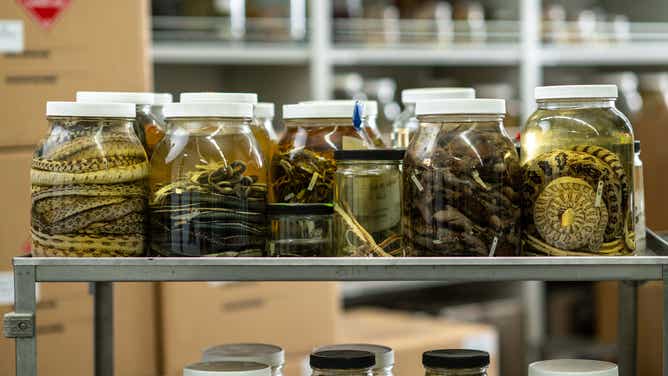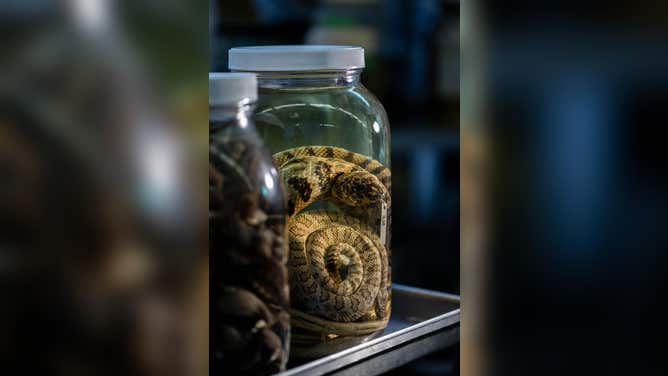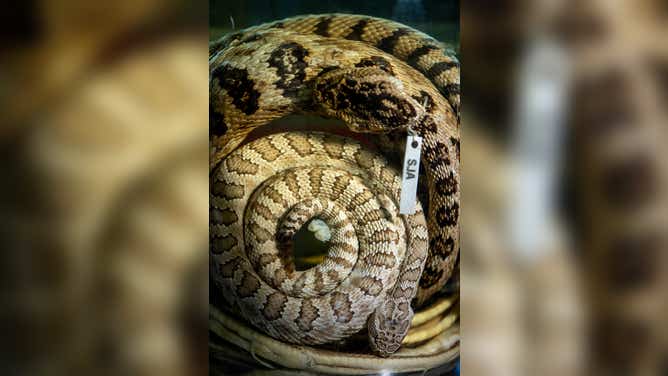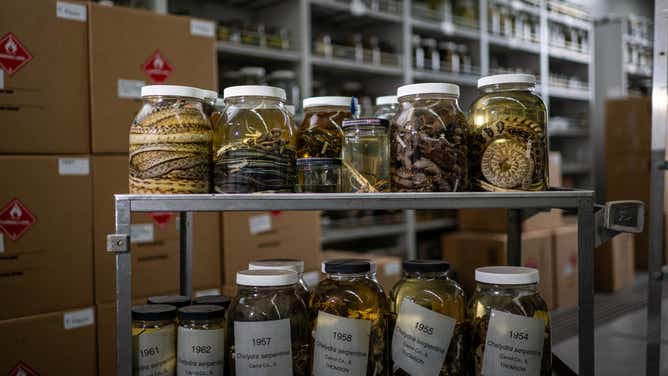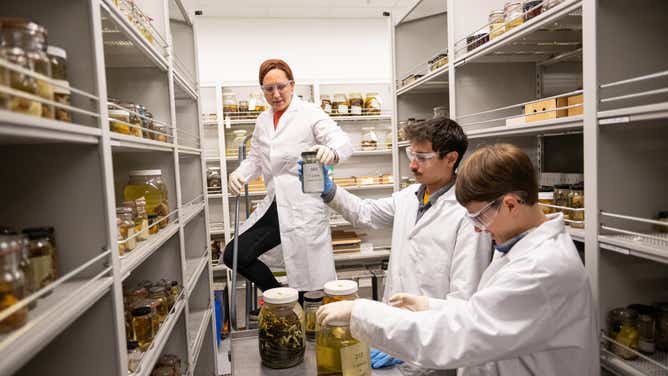University of Michigan museum now home to largest collection of snakes in the world
A recent gift of specimens from Oregon State University pushed the University of Michigan Museum of Zoology into the record books. But this is no stereotypical museum, professors say. The collection allows students to track a species change after climate and natural disasters.
Watch: Students unpack largest collection of snakes in the world
"It's like Christmas," said an undergrad helping to unpack the world's largest collection of snakes at the University of Michigan. A gift from another university almost doubled the Museum of Zoology's collection.
ANN ARBOR, Mich. – The University of Michigan has slithered into the top spot as home to the largest snake collection in the world.
Oregon State University recently gifted the UM Museum of Zoology 45,000 specimens of reptiles and amphibians. Over 30,000 of those were snakes, which almost doubled the school's research collection and put it into the record books. The collection is not open to the public but available to scientists across the globe.
This is not your traditional dusty museum though. Curators call the hundreds of jars filled with snakes and salamanders in alcohol and frozen tissue specimens, "active and vibrant".
AMERICA'S RAREST SNAKE FOUND CHOKED TO DEATH ON GIANT CENTIPEDE IN FLORIDA
"These samples represent a biological ‘time capsule’, where researchers can go back to look at populations of animals from decades ago to understand their genetics, their diseases and other things," said curator and evolutionary biologist Dan Rabosky.
"Why should we care about this?" he continued. "Well, if we want to understand how things change over time, such as how diseases spread through animal populations, one of the most important kinds of data are these biological time capsules."
‘This is like Christmas’
Students spent part of a day unpacking the specimens for the first time.
"This is like Christmas," undergrad Drew Heur said on the video as he pulled out a large jar teeming with snakes in preserving liquid. "Nice."
WHERE DO SNAKES GO IN THE WINTER?
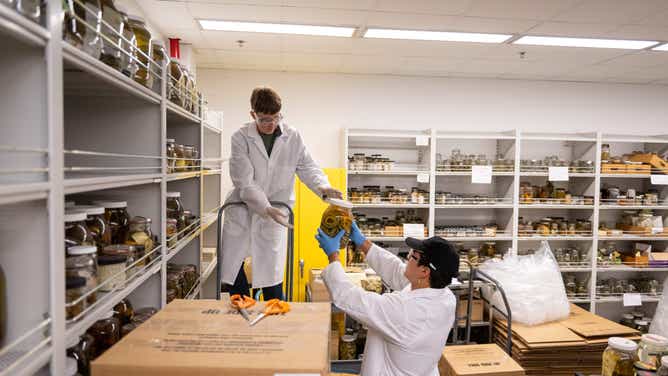
U-M doctoral student Natasha Stepanova, left, and undergraduate Drew Heur shelve a jar of snakes preserved in alcohol. The U-M Museum of Zoology recently acquired about 45,000 reptile and amphibian specimens from Oregon State University. The specimens were delivered to U-M's Research Museums Center by truck, packed inside 115 cardboard boxes. The newly acquired material also included frozen tissue samples delivered in ultracold freezers.
( Eric Bronson Michigan Photography / FOX Weather)
"He's huge," said Ph.D. candidate Hayley Crowell, on the video, as she pulled a fat water snake from a jar. "He's a monster of a snake."
She said that the collection, spanning about 50-years, shows how species changed after a natural disaster.
"So if there was a major event, say, climate event or a landscape change, which was a forest fire or maybe a certain habitat was changed or destroyed or water availability changes, we can actually track what those changes do to these populations over time based on the specimens we have here," she said.
She said having hands-on access to a wild population of animals over time for research is an opportunity "few and far between" compared to lab studies.
SNAKES ON THE MOVE: MATING SEASON AND WARMER WEATHER MAKE SERPENTS FRISKY
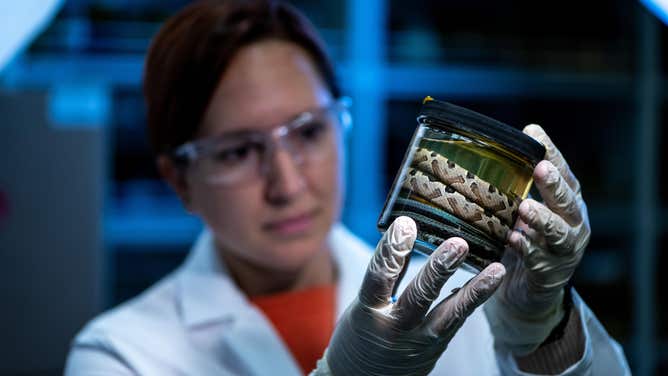
U-M graduate student Hayley Crowell examines a jar containing a copperhead snake from North Carolina and a garter snake. These snakes are preserved in alcohol and are two of the roughly 45,000 reptile and amphibian specimens the U-M Museum of Zoology acquired recently from Oregon State University.
(Eric Bronson, Michigan Photography / FOX Weather)
"So we can learn a lot about what happens in natural ecosystems, in populations in situ, not just in Petri dishes in the lab, which is one aspect of it," she said. "But seeing where things happened without human manipulation in of itself tells us so much about the way the world works. And, that's rare and it's cool."
Rabosky said the collection allows scientists to understand how species are changing through time and adapting to long-term changes, like the weather and climate.
"So, while the data are ‘snakes’, their importance is really much more general because we can use them as a model for understanding much more complicated biological processes," he said. "Some of the very best science is when researchers can use insights from things like snakes, or other seemingly random kinds of animals or plants, to develop deep insights into very general questions, such as how diseases spread. And those insights might even help us better understand the spread of disease in human populations."
Collection is culmination of lifetime of work
PHOTO CAPTURES MOMENT RARE FLORIDA PINE SNAKE DEVOURS COTTONTAIL RABBIT
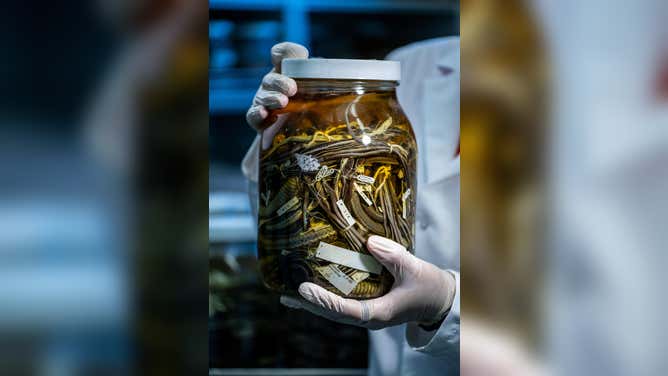
A jar full of garter snakes preserved in alcohol, part of the roughly 45,000 reptile and amphibian specimens the U-M Museum of Zoology acquired recently from Oregon State University.
(Eric Bronson, Michigan Photography / FOX Weather)
He said don't look at this as the "stereotypical storage room" that many associate with museums. The collection is more like "a giant scientific instrument" like a telescope or a particle accelerator. He offered a comparison.
"For the science of medicine, we often use traditional laboratory rats or mice to answer questions. But out in the world beyond the laboratory, in nature, the things we can learn from lab animals don’t necessarily apply," Rabosky said. "Having this snake dataset will let researchers answer some of the ‘big questions’ about why life on Earth is the way it is; how do animals adapt to new conditions; how do new species/kinds of animals form; how do animals like snakes seem to ‘work so well’ and how are they so successful even though they lack legs."

A mountain newt from Iran preserved in alcohol inside a glass jar. The University of Michigan Museum of Zoology recently received a delivery of 45,000 or so reptile and amphibian specimens from Oregon State University.
( Eric Bronson, Michigan Photography / FOX Weather)
Jars contain more than snakes. Lizards, salamanders, newts, frogs and turtles along with nature films, lab notes and field notebooks arrived in supercooled freezers and boxes.
According to the school, the collection represents a lifetime of work of two recently retired Oregon State professors. One earned a Ph.D. from Michigan. Rabosky said that the UMMZ was one of the only museums with resources capable of maintaining the collection and making it available to the scientific community.

